Red Squirrel is holding a tulip between Daphne and leaves looking away by Geert Weggen.
Out my window one morning, I watched as a quick, silvery-gray coated squirrel used his tiny, hand-like paws to pull a slender, delicate green stem down closer to the ground. He deftly used his little feet to hold the tender stalk in place, took those little paws and pulled the vibrant tulip—resplendent in red, yellow, and a fiery orange hues—to his face. He buried his little rodent face inside the bloom, perhaps eating up the pollen dusting the defiant pistil and stamens; perhaps just trying to soak up the brilliance and vibrancy of those spoon-shaped petals. After a few moments of his petal bathing, he popped the bloom off with those efficient little hands and dropped it on the ground.
It made me mad.
I love spring bulbs. I take great comfort in looking out my windows, in walking up the 30 stairs to my front door and seeing my gardens ablaze with the unabashed display of spring blooms—brash, cherry-red tulips; triumphant lemony daffodils; dense clusters of blue, bell-shaped grape hyacinths. These blooms, demonstrating their brash emergence after the coldness of winter, pushing their early shoots through hard, semi-frozen ground; celebrating their luck in dodging the busy hands of squirrels and chipmunks searching for tasty bulbs in the dead of winter, the burrowing intensity of the voles and field mice—they are a reminder that color and exuberance and defiance follow the unforgiving, desolate, iciness of winter.
I have seen a squirrel do this before. I knew that squirrels were a primary cause of the disappearance of certain daffodils and tulips every spring. The protein-packed bulb a desirable find in the midst of winter. And you can’t blame a critter for trying to survive. But the squirrels in my backyard live high on the hog. They are plump, well-nourished little creatures. They emerge from the winter popping the buttons off their fur coats due to a plentiful winter season. Why are they indulging themselves in my tulips? Surely they don’t need the scant protein offered by a dusting of pollen.
In the past few years, I have become fiercely protective of my well-being. I have put conscious thought into what comes into my mind, my heart, my soul. I have stopped listening to the news, carefully monitored my written news sources, and become increasingly more boundaried about even the conversations in which I engage around the state of the world. That doesn’t mean I am ignorant of a world falling apart around me. It remains, sometimes at the edges of my consciousness, sometimes moving closer in. When we took L to visit a college campus, I wondered how long this prestigious school with its coveted and hard-earned R1 classification would hang on to its research programs, how long before the impact of senseless and chaotic slashing of government funding would level this university. When Z talked about the state scholarship he received last year, I held myself back from warning him that the funding might not exist for the next academic year. When I read the summary of our city’s latest school committee meeting, I wonder, for a moment, if this struggle to even stay afloat next school year is a harbinger of hardship to come.
When I head into work early on Monday morning, I focus on the way the dawn looks as if it is burning of the darkness of night—the fiery blush of peach, pink, and brilliant yellow that pushes out the inky midnight blue of the night sky. I think about the tasks ahead of me—the appointments quickly filling in my work hours, the Veterans I am coming to understand and help through the hardships they are facing, the trainings and meetings that still feel novel and exciting to me. I center my gratitude to be doing work that feels meaningful and able to slightly edge the needle toward healing and change. I think about the reconnections and new connections that come with once again having a hospital full of colleagues all focused on supporting Veterans in their path toward recovery and wellness. I try to keep the worries about haphazard reductions in force, showy displays of cruelty and indifference toward the violence and devastation these decisions have on people’s lives, on their ability to survive—to make rent or mortgage payments, to feed their families, never mind higher-order goals like college tuition or retirement. To ignore the email directing all employees to be on high alert for anti-Christian bias at work, a blatant mockery of the decimation of rights for trans people, immigrants, women, people of color, the list sometimes feels endless.
I read an article recently, The Despair of the Young, and it broke my heart. Mary Gaitskill writes poignantly and with urgency about a trend she has observed in her several decades of teaching college students. Our young people are exhibiting deeper and deeper psychological distress and a diminished sense of hope. Their writing has turned more and more to human violence—murder, rape, profound trauma—and they are often writing from the perspective of the perpetrator of these horrifying acts. And we, the grown-ups, the adults, the college administrators and parents, are failing them. These are the observations that I can only lightly hold without falling into my own panicky place of despair. Have I done enough to try and buffer the awfulness of the world for my children? Is L’s entitled response to me masking a suicidal despair that I have somehow missed? Is Z engaged enough at school? Has he made good friends? Is M’s tendency to prefer the comfort of home to social situations a sign of some significant anxiety that I have failed to sufficiently address? Would my child write these gruesome stories that Gaitskill describes? If they did, what would it mean about their well-being?
So, you see, I often feel I am navigating a narrow path between the beauty and promise and connection of a world characterized by hope and possibility and ever-forward moving progress and one that is dark and sinister and disconnected. A world that is run by despots intent on seizing more and more power and money, with no regard for the citizens, the humans that are trying to eke out a meaningful life.
I imagine so many of you feel the same.
How do we raise our children in this world? How do work on our relationships, keep our marriages stable and even thriving when the future feels unknowable? How do we make plans for the future when the idea of October feels so uncertain?
A client asked me what I thought about the concept of denial. I explained that it was a survival technique employed when a situation was so overwhelming or threatening that the best available coping mechanism was to pretend it didn’t exist. If you can’t cope with it, though, she asked, is it really denial? Are you really able to confront it if it is something your heart or mind has deemed is too damaging to enter your reality?Before this time, before the pandemic, when life had more certainty for many of us, I would have talked about denial as a conscious decision. Something that was necessary in the face of the situation or events, but afterward, once relative emotional and physical safety was obtained, was a choice made because of an avoidance of the emotional pain and consequences involved in confronting that past. But when so much feels in question, when we can’t count on programs that fund childhood cancer research being continued, when Head Start is threatened, Social Security and Medicare are painted as entitlements—not benefits we have all paid into since we got our first jobs, what is denial? Can any of us really hold the reality of our current world?
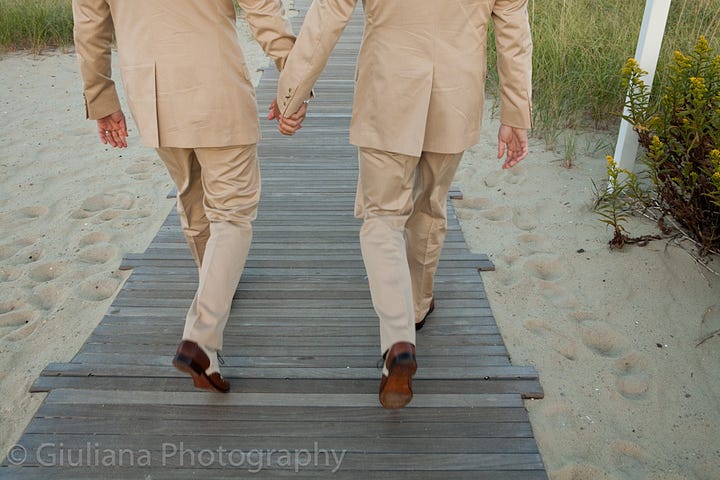
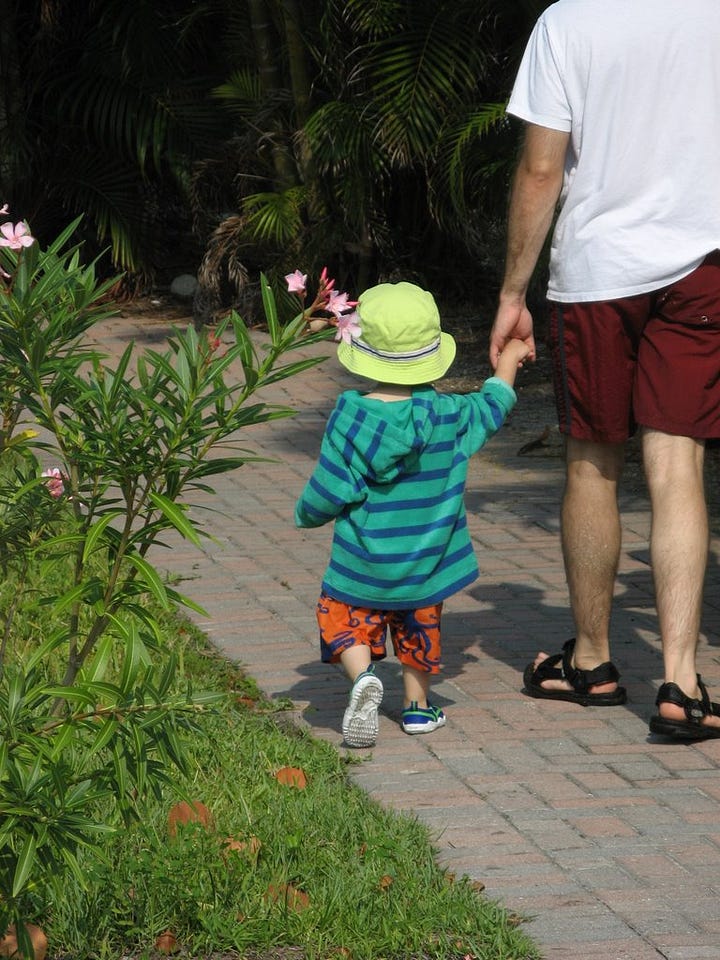
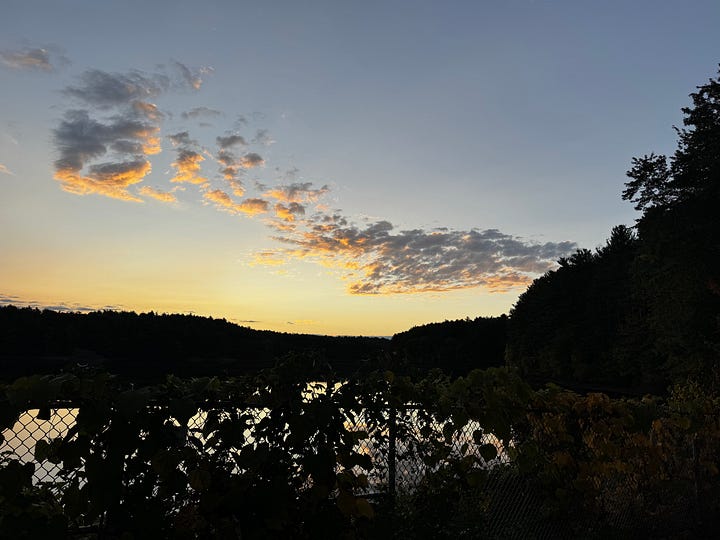
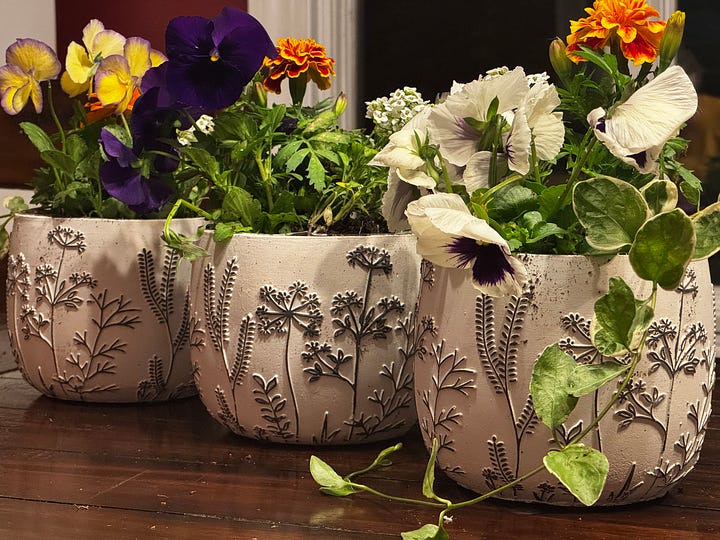
The way to survive this, I think, is to focus on the beauty, the connection, nature, the small sparkling moments of joy. A walk in the woods with friends. Potting pansies and marigolds and periwinkle to leave anonymously on doorsteps to celebrate the arrival of spring. The little window when L lets me in. The small note of pride when Z talks about his classes this semester and his continued progress toward a degree he is invigorated by. M taking in a live jazz concert and wanting to see more. The comfort of a hand that has held mine for almost 32 years. A friend trusting me with her sadness, her worry, her pain. A friend hearing my uncertainty and holding it with me. A shift in perspective when I offer a client another way to see. The glow of spring sunrises. The warmth and light coming back after the cold and dark of winter.
The boldly defiant red of my tulips.
And yes, the daring of the squirrel burying his little head in that same tulip, trying to drink in all that beauty.
Isn’t that what we all want? The ability to immerse ourselves in beauty, brilliance, color, life?
Isn’t this why the Thoreau quote that is so familiar it is almost trite remains so deeply resonant?
I went to the woods because I wished to live deliberately, to front only the essential facts of life, and see if I could not learn what it had to teach, and not, when I came to die, discover that I had not lived. I did not wish to live what was not life, living is so dear; nor did I wish to practise resignation, unless it was quite necessary. I wanted to live deep and suck out all the marrow of life, to live so sturdily and Spartan-like as to put to rout all that was not life, to cut a broad swath and shave close, to drive life into a corner, and reduce it to its lowest terms...
Henry David Thoreau
Here is to living deliberately, deeply, sucking all the marrow out of life. To not practicing resignation, not driving life into a corner, reduced to its lowest terms.
Here is to bending the slender stalk of joy closer to us and burying our face in the beauty of it all.
Kindness
~Rosemarry Wahtola Trommer
Consider the tulip,
how it rises every spring
out of the same soil,
which is, of course,
not at all the same soil,
but new. How long ago
someone’s hands planted a bulb
and gave to this place
a living scrap of beauty.Consider the six red petals,
the yellow at the center,
the soft green rubber of the stem,
how it bows to the world. How,
the longer we sit beside it,
the more we bow to it.It is something like kindness,
is it not? The way someone plants
in you a bit of beauty—a kind word,
perhaps, or a touch, the gift
of their time or their smile.
And years later, in the soil that is you,
it emerges again, pushing aside
the dead leaves, insisting on beauty,
a celebration of the one who planted it,
the one who perceives it, and
the fertile place where it has grown.
All photos were taken by the exceptional Dana Giuliana, unless otherwise noted.
Thanks for spending some of your day reading this post. I hope it resonated. Periplum of motherhood and other wonderings is free. If you enjoy reading, please share it with friends!





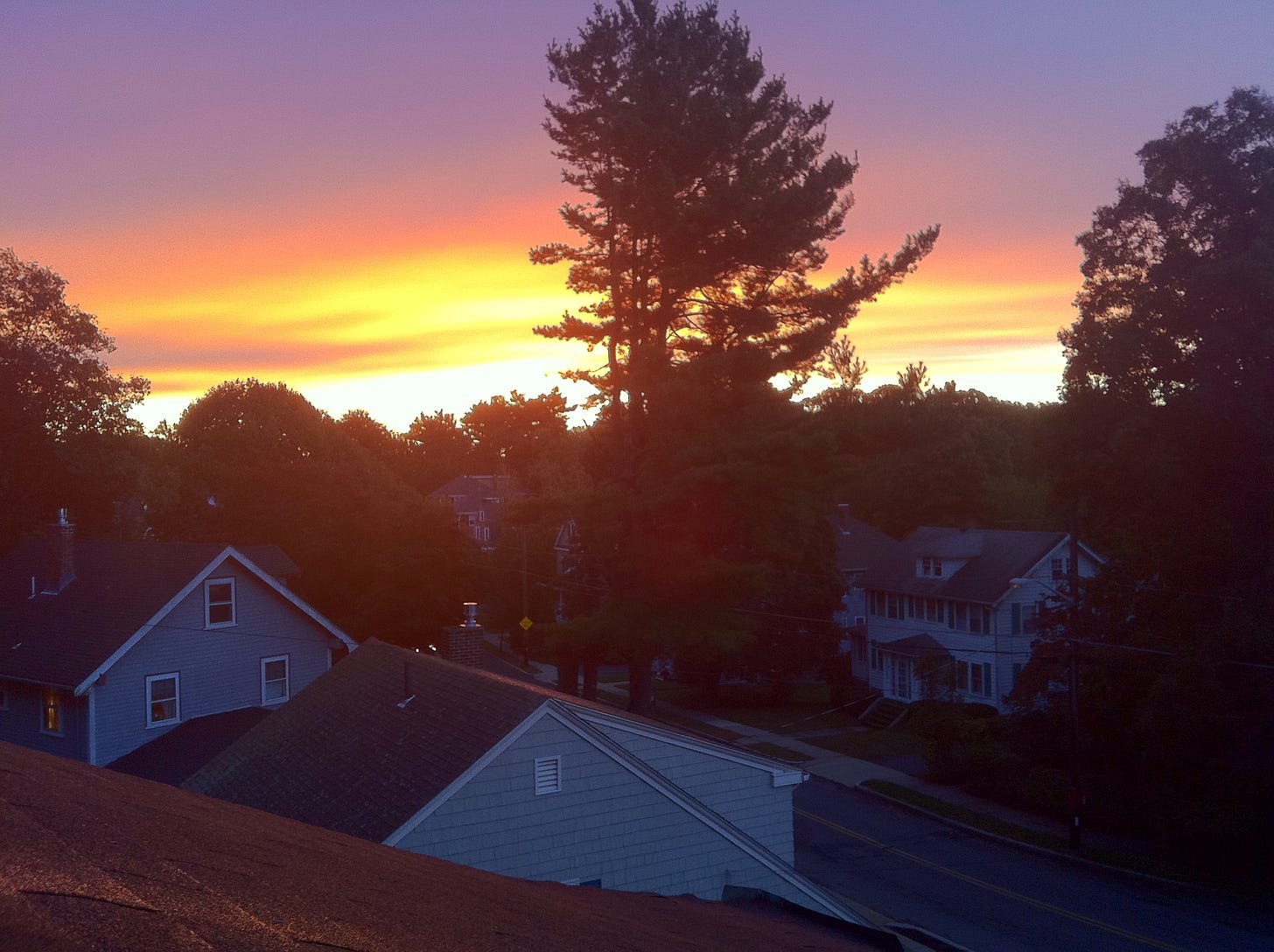

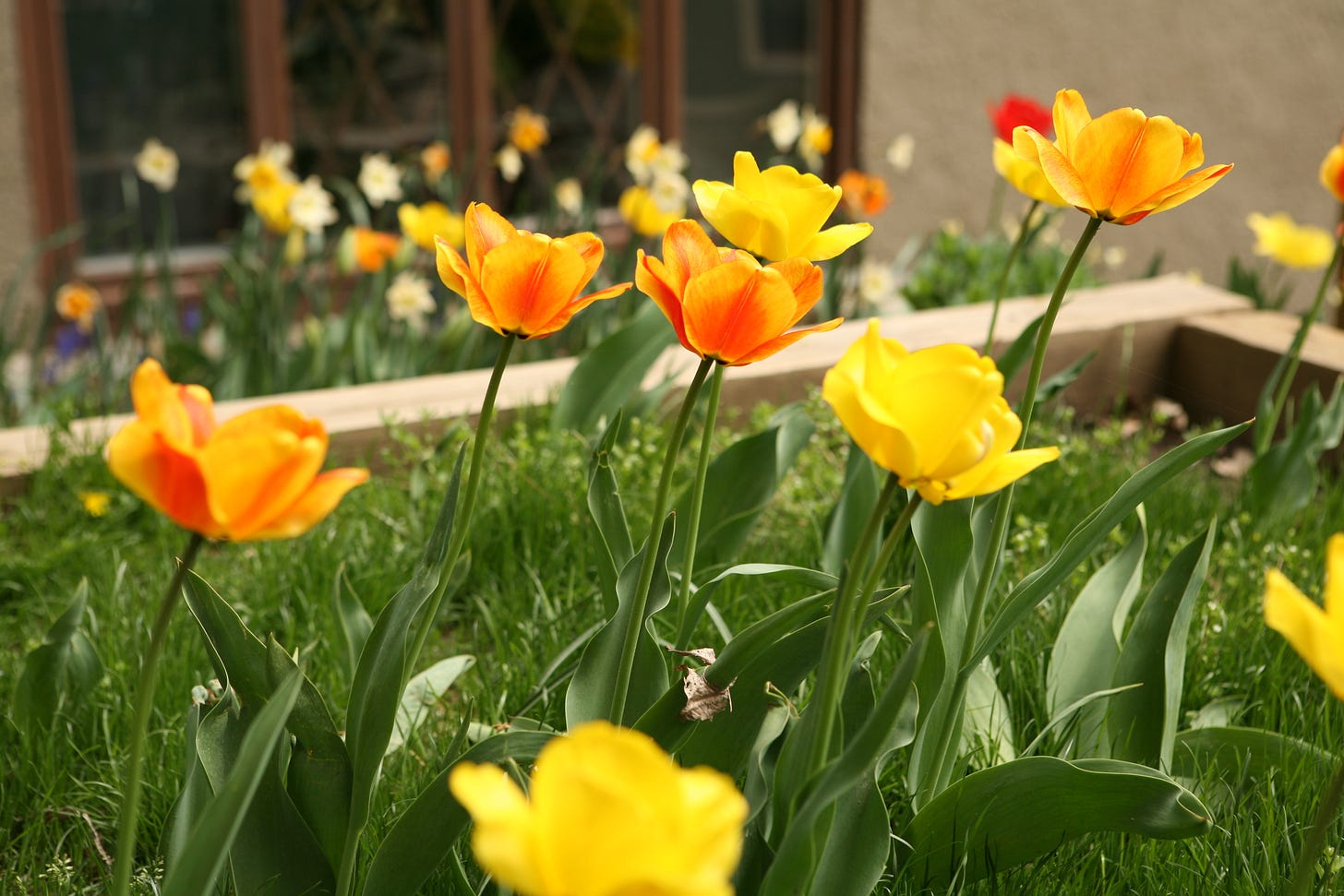
Love in the knife-edge balance.